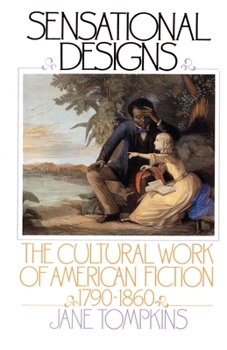Sensational Designs: The Cultural Work of American Fiction, 1790-1860
Select Format
Select Condition 
Book Overview
In this provocative book, Jane Tompkins seeks to move the study of literature away from the small group of critically approved texts that have dominated literary discussion over the decades, to allow inclusion of texts ignored or denigrated by the literary academy. Sensational Designs challenges comfortable assumptions about what makes a literary work a "classic."
Format:Paperback
Language:English
ISBN:0195041194
ISBN13:9780195041194
Release Date:May 1986
Publisher:Oxford University Press, USA
Length:256 Pages
Weight:0.78 lbs.
Dimensions:0.6" x 5.6" x 8.6"
Customer Reviews
3 ratings
Explodes the Canon!
Published by Thriftbooks.com User , 15 years ago
The classic Sensational Designs is the best written of those books which led the challenge to the hegemony of the literary canon. Tompkins' arguments are clear and persuasive, not bogged down with a surfeit of theoretical clutter.
Decisive 4 19th Century American Literary Studies & History
Published by Thriftbooks.com User , 19 years ago
Jane Tompkins' Sensational Design has had a revolutionary impact on the study and our understanding of "literature" and is also important to our understanding of 19th Century literature and women's studies as well. It is also nicely put together, clear, incisive, and provides the joy that comes from reading a book that explains things right that have been either explained wrong forever, or never explained before. Literature and canon are artifical categories constructed after the fact usually under the impact of political, sexual, and social dominance, not necessarily literary achievement, whatever that is, and not at all readership. Tompkins explodes the idea of the American Literary Renaissance by pointing out that Sentimental Women Writers like Susan Warner and Harriet Beecher Stowe were selling hundreds of thousands of copies of their books, while Hawthrone never sold more than a few thousand coies of anything. Even with Hawthrone she explains how the different attitudes of readership and thought made the Marble Faun, a work much neglected and unread, be considered as his most important work in his time. She also does mention how history might not have been as kind to Hawthrone's place in literature had he not married his children into families that controled the Atlantic Monthly and what would become the Harvard Literature department. More importantly, Tompkins unravels the mechanisms of the Sentimental novel such as Warner's The Wide Wide World and Stowe's immortal Uncle Tom. Tompkins explains how the text's purpose was the create "sympathy" seen in the physical form of tears, and how much of their approach corresponded with the notions of reality comment among its readership. This work belongs on the shelf of anyone who seeks a serious knowledge of American literature and of 19th Century Culture. Moreover, the insights she provides on Uncle Tom make this book a must for people interested in the storm of literary discourse the book provoked among African American writers on one side and pro-slavery writers on the other.
How is a "Classic Text" Made?
Published by Thriftbooks.com User , 23 years ago
This is one of the books that started the new-historical feminist reinterpretation of books that suffer as "bestsellers" and "pulp" (often women's literature) as history (and a group of "insiders") decide what books go on to become "classics" and which do not. Tompkins reveals the historical and socio-political factors that affected Nathaniel Hawthorne's "classic" status and shows us why other authors, including Harriet Beecher Stowe and Susan Warner, slipped into relative obscurity and/or disfavor following their popularity during their lifetimes. She does not dispute the richness of Hawthorne's writing, rather points out that the "canon" changes over time, and the books that fall in or out are subject to individual and political pressures. For anyone who ever wondered "why aren't there more books by "women/minorities/--- fill in blank" in the canon, this book is AN explanation. Maybe not the only one-- but a good explanation in very accessible language.




